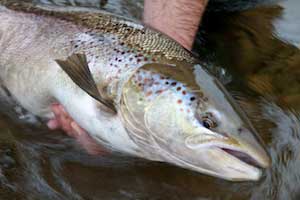Atlantic Salmon Autumn Fishing

Fall Food Binge
Before the fall spawn, landlocked salmon return to the surface and actively feed.
Fall fishing doesn’t yield the same degree of catches as spring fishing. However use streamers, spinning lures and thin-bladed spoons.
The sea-going Atlantic salmon are only available during their short spawning season. However they can also be caught in the open ocean, and the first salmon to reach the rivers and streams connecting to the Atlantic Ocean are the fish that sporting anglers love to catch.
A highly recommended salmon fishing outfit consists of a well-made 8 1/2 trout rod with a strong backbone and a reel with a 3 1/4 inch diameter spool with 150 yards of 15 pound test backing.
- Under normal water conditions use a 7 1/2 foot leader tapered to a tippet of 4 pounds.
- When conditions are low and clear use a 9 1/2 foot leader.
Atlantic Salmon Flies
For Northern American anglers the only legal method of catching the Atlantic salmon is by using artificial flies. Both wet or dry flies work well. Modern patterns, simple to tie and comprising little more than a fluorescent body and bright wing are more effective for all fly-fishing levels. Small No. 6 and No. 8 flies cast without a tail produce under average water conditions.
- In high and discolored waters use the larger No. 4 flies
- Under low and clear conditions, use the smaller No. 12 flies
- Generally darker flies will work best on clear bright days
- Brighter flies coax strikes on gray days and in murky waters
Water Habitat
Atlantic salmon prefer moderately flowing rivers where there are obstructions close to the bank and where the temperature is between 65°F/18°C and 70°F/12°C.
You’ll find these are the 3 best places to cast.
- where the current changes
- over gravelly bottoms submerged in high waters
- in high water in long expanses of flat water below large pools
The best place to fish the deep pools is from a boat or canoe. Anchor yourself at the head of the pool, casting 30 or 40 feet to different spots in the pool. Now move slightly downstream and repeat.
Salmon Fishing Tips
While trout and salmon are very similar fish, salmon are caught in a very different manner than trout. These are the main differences.
- Trout anglers use the approach of presenting flies to actively feeding fish.
- Several casts are often required to persuade or anger salmon to strike.
- Trout like to sit in familiar areas of the stream where the fast current brings food to the waiting fish.
- However salmon swim to different stretches of the river and streams and rest in the calm lengths away from the drifting current. Many trout anglers avoid these salmon hotspots, unaware that the salmon are not searching for food carried by the current.



